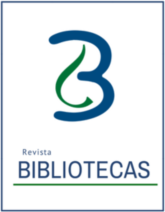Library: a complex social organization
Keywords:
Library as a social organization, library planning, information policy, capital, information managementAbstract
The library as a social organization is affected in their organizational levels as it depends in most cases of an institution with a mission and vision itself. Simultaneously is governed by LIS theoretical and methodological principles that make an information system. At another level, and extra-social elements intrasocietal one way or another not only modify the library work, but also library development plans, the particular programs to be implemented in library systems and internal procedures in order to have an organization dynamic and functional, to provide access to information that is demanded by users. Achieving a communion between the various levels of organization and between the above elements, it becomes a complex organization. The objective pursued in this paper is to review what the library features that make it a complex organization; what are the interrelationships of the library and extrasocial intrasocietal identified elements; and how social capital is built in different nuclei of society through access to information.
References
Burnett, G. y Jaeger, P.T. (2008). Small worlds, life worlds and information: the ramification f the information behavior of social groups in public policy and the public sphere. Information Research, 13 (2). Disponible en: http://informationr.net/ir/13-2/paper346.html.
Burnett, G., Besant M. y Chatman E.(2001). Small worlds: normative behavior in virtual communities and feminist bookselling. Journal of the American Society for Information Science and Technology, 52(7). pp. 536-547.
Burnett, G., Jaeger, P.T. y Thompson, K.M.(2008). Normative behavior and information: the social aspects of information access. Library & Information Science Research, 30, pp. 56-66.
Chatman, E. A. (1985a). Low income and leisure: Implications for public library use. PublicLibraries, 24, pp. 34-36.
Chatman, E. A. (1985b). Information, mass media use and the working poor. Library & Information Science Research, 7, pp. 97-113.
Chatman, E. A. (1986). Diffusion theory: a review and test of a conceptual model in information diffusion. Journal of the American Society for Information Science and Technology, 37, pp. 377-386.
Chatman, E. A. (1987). Opinion leadership, poverty and information sharing. Reference Quarterly, 26, pp. 341-353.
Chatman, E. A. (1987). The information world of low-skilled workers. Library & Information Science Research, 9, pp. 265-283.
Chatman, E. A. (1990). Alienation theory: application of a conceptual framework to a study of information among janitors. Reference Quarterly,29, pp. 355-368.
Chatman, E. A. (1991). Channels to a larger world: older women staying in contact with the great society. Library & Information Science Research, 13, pp. 281-300.
Chatman, E. A. (1991). Life in a small world: application of gratification theory to information seeking behavior. Journal of the American Society for Information Science and Technology, vol.42: 438-449.
Chatman, E. A. (1996a). The impoverished world of outsiders. Journal of the American Society for Information Science and Technology.47, pp. 83-92.
Chatman, E. A. (1996b). Social context and culture: linking use and digital libraries. (1996). Digital Libraries Workshop. Disponible en: http://is.gseis.ucla.edu/research/dig_libraries/chatman.html.
Chatman, E. A. (1999). A theory of life in the round. Journal of the American Society for Information Science and Technology, 50, pp. 207-217.
Chatman, E. A. y Pendleton, V. (1995). Knowledge gap, information seeking behavior and the poor. Reference Librarian, 49-50, pp. 135-145.
Galbraith, J.y Lawler,E. (1993). Organizing for the future: the new logic for managing complex organizations. San Francisco, California : Jossey-Bass.
Galbraith, J. (1973). Designing complex organizations. EE.UU : Addision Wesley.
Galbraith, J. (2002). Designingorganizations: an executive guide to strategy, structure and process. San Francisco, California :Jossey-Bass.
International Federation of Library Associations. (2007). Manifiesto sobre el internet de la IFLA. IFLANET. Disponible en:http://archive.ifla.org/III/misc/im-s.htm.
International Federation of Library Associations. (2008). Manifiesto IFLA por la Biblioteca Multicultural. Disponible en: http://archive.ifla.org/VII/s32/pub/MulticulturalLibraryManifesto-es.pdf
International Federation of Library Associations. (XXXX). Manifiesto UNESCO/IFLA sobre bibliotecas escolares. Disponible en: http://www.unesco.org/webworld/libraries/manifestos/school_manifesto_es.html.
Kickert, W.(1983). Research note: research models underlying situational dependency.Organization Studies,4(1), pp. 55-72.
Lakos, A. (1999). The missingingredient –culture of assessment in libraries. Performance Measure and metrics.Sample Issue, pp. 3-7.
Luckmann, B. (1970). The small life-world of modern man. Social Research, 3, pp. 580-596.Stamper, R. (1988). Analyzing the cultural impact o a system. International Journal of Information Management,8, pp. 107-122.
Tolbert, P. S. y Hall, R. H. (2009). Organizations: structures, processes and outcomes. 10 ed. New Jersey, EE.UU, Pearson-Prentice Hall.
Unruh, D. (1980). The nature of the social worlds. Pacific sociological Review, 23(3), pp. 271-296.
Urry, J. (2005). The complexities of the global. Theory, Culture and Society, 22 (5), pp. 235-254.
Urry, J. (2005). The complexity turn. In Theory, Culture and Society, 22(5), pp. 1-14.
Downloads
Published
How to Cite
Issue
Section
License
Bibliotecas provide immediate open access to their content, based on the principle of facilitating research to the public free of charge and free of charge to promote the global exchange of knowledge.
The journal Bibliotecas is a publication hosted by a public higher education institution, which is supported by public resources. Since its inception, the magazine has offered all its contents free of charge without any restriction on the rights of: reading, downloading and printing in full text. Works published in libraries may be analyzed, quoted and reproduced in whole or in part, mentioning the original source.
The journal Bibliotecas is licensed under the Creative Commons Attribution - Non-Commercial - Share Equal, 4.0 International license; therefore, it is allowed to: share, copy and redistribute the material in any medium or format.

Este obra está bajo una licencia Creative Commons Atribución-NoComercial-CompartirIgual 4.0 Internacional.








